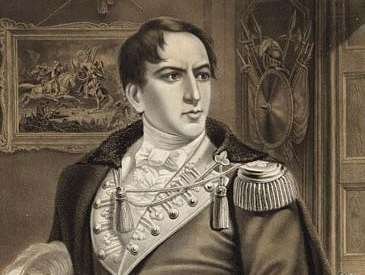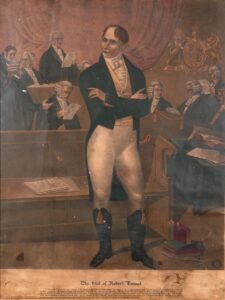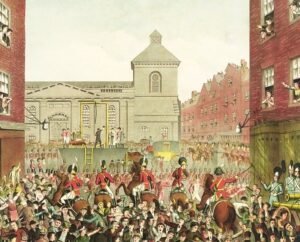Robert Emmet: Ireland’s most Romantic Rebel

Although it can now celebrate almost a century of independence, Ireland is a country with a bit of a reputation for failed rebellions. Even the famed 1916 Easter Rising could technically be considered a failure, given that most of its leaders were caught and executed within days. However, there is one doomed Irish patriot whose memory sticks out above all others: Robert Emmet. This Dubliner was the famous leader of the unsuccessful 1803 rebellion against British rule. He was executed for his actions, but his legacy would inspire Irish rebels to take action over 100 years after his death.

Early Years
Robert Emmet was born in March of 1778 to his father, Dr. Robert Emmet, and his mother Elizabeth Emmet (neé Mason). Robert Emmet senior was a doctor to the Lord Lieutenant of Ireland, the title given to the chief governor of Ireland while the island was under British rule, so the Emmets were a wealthy family. They lived at house number 109 on Dublin’s fashionable St. Stephen’s Green and also owned a country home named Casino to the south of the city. Dr. Emmet and Elizabeth were both members of a social class known as the Protestant Ascendancy, a powerful minority group that existed in Ireland from the 17th to the 20th century which was made up of people who were both members of the Church of Ireland and descendents of English settlers. Despite this, Dr. Emmet was a supporter of the Irish patriot movement, and famed Irish revolutionary Theobald Wolfe Tone was a good friend of his eldest son, Thomas Addis Emmet. Thomas Emmet and Wolfe Tone were both members of the secret republican group the United Irishmen and these were the politics that influenced young Robert Emmet’s worldview as he grew up.
Education
During his childhood Emmet was educated at various different places in the city, including schools on both Grafton street and Camden street, before entering Trinity College in October 1793 at the age of fifteen. Because he was a Protestant, Emmet was free to enroll in the university while Irish Catholics at the time were banned from entering. In 18th century Ireland Catholics were also not allowed to vote and were excluded from many public positions. These restrictions on the political freedom of Catholics were one of the major issues that led to support for an independence movement, as the majority of the population belonged to the Roman Catholic Church. Emmet would eventually be expelled from Trinity College in 1798 after it was discovered he was the secretary of a secret committee that supported the United Irishmen, but before he’d been forced to leave he had been recognised as a gifted speaker and debater.

The United Irishmen
1798 was also the year of the United Irishman rebellion, of which Wolfe Tone was an influential leader. Inspired by the recent revolutions in America and France, the Irish rebellion began in May and dragged on until October, claiming tens of thousands of lives, including that of Wolfe Tone himself. Emmet’s older brother Thomas was captured by the British and held in Fort George in Scotland, but the two siblings managed to communicate occasionally and Emmet even visited the prison in 1800. Emmet had not been directly involved in the fighting himself, but he played a big part in rebuilding the United Irishmen after their defeat. Under Emmet the society was reorganised on military lines, and its aim was to encourage the new French Republic to invade Ireland in the hopes that this move would push the British out. Emmet managed to present his ideas to Napoleon Bonaparte, who was France’s leader at the time, and was soon under the impression that a French invasion of Britain was a sure thing. It was with this in mind that he began to seriously plan his own rebellion.
Rebel Leader
By 1802 several veterans of the United Irishmen Rebellion had been released, breathing new life and excitement into the planning for the next rising. The French Revolutionary Wars were raging on the continent, and Britain’s involvement led Irish republicans to believe the country would be spread too thin to respond to another rebellion. The United Irishmen were also in touch with another republican group, the United Britons, who it was hoped would launch their own revolt in London at the same time. Unfortunately in November of that year the authorities moved in on the United Britons and their leader, Edward Despard, was executed the following February of 1803. This was a great discouragement to the Irish rebels, but they continued in their planning, stockpiling guns and ammunition at several locations around Dublin city. Emmet and his followers had been holding out for French forces to cross the English Channel in August 1803 but their plans would be disrupted by an accidental explosion on Patrick Street, caused by their hidden weapons. The United Irishmen were immediately made vulnerable to exposure. Emmet came to the conclusion that it was now or never and, against the advice of his co-conspirators, launched an attempt to seize the capital on the 23rd of July.

Failure and Capture
Emmet’s first move was to issue 10,000 printed copies of a proclamation declaring the “Provisional Government”. The document acknowledged that the revolutionaries would have to act without any foreign assistance, declaring the United Irishmen would “look only to our own strength”. The proclamation also assured its readers that the rebellion’s sole aim was to throw off English rule, and that it did not have any concerns with class or religion. To this day only two copies of the declaration have survived.
The actual fighting itself was short-lived and disorganised. The last-minute notice meant that the majority of the forces simply did not show up, while Emmet’s plan to spring a surprise attack on Dublin Castle and capture the Lord Lieutenant was an ill-timed failure. By the evening of the 23rd there were less than 100 men fighting under the rebels. During the night of unrest that followed the most notable casualty was the murder of Lord Kilwarden, the Lord Chief Justice of Ireland, who had been dragged from his carriage and stabbed. Realising that the rebellion had been a complete disaster, Emmet quickly went into hiding, where he remained until his capture on the 25th of August. On the 19th of September he was convicted for the crime of high-treason against the British Crown and was hanged, drawn, and quartered the very next day. Out of fear of facing arrest, none of his friends or family dared come forward to collect the body.
Legacy and Romance
Reading over the bare facts of Robert Emmet’s life, you would be forgiven for wondering why he made such an impression upon recent Irish history. His attempted rebellion was by far the least impressive and most disorganised of the nationalist movement, especially when sandwiched between the famous risings of 1798 and 1916. However, it was precisely because of his failure that Emmet was so easily transformed into a martyr-figure for Irish republicanism. Over a century after his execution the famous Irish nationalist Pádraig Pearse would see Emmet’s death in terms of an almost mystical blood sacrifice in the name of “that deathless thing we call Irish Nationality”. Emmet himself contributed to his reputation as a romantic hero with the rousing speech he gave in defense of himself while on trial, where he declared himself unafraid to die and stated that he did that he did not wish his tomb to be inscribed until the day that Ireland could take “her place among the nations of the earth”. He made such an impression on the Chief Secretary for Ireland, William Wickham, that the man handed in his resignation, saying that he could not remain at the post in good conscience after the death sentence that had been handed to Emmet.

During the Great Famine of the 1840s Emmet was adopted as a heroic figure by the Young Irelanders group, and an idealised version of his life began to circulate, with many songs and poems being dedicated to his memory. The most famous of these remains “O, Breathe Not His Name”, which tells of the grief experienced by Emmet’s fiancée Sarah Curran, furthering his status as a romantic hero.
Owing to the fact that no one came forward to claim his body, the whereabouts of Emmet’s resting place remains an enduring mystery. He was originally brought to Bully Acre, now the grounds of the Royal Hospital Kilmainham, but when a group of friends finally came forward to have him properly buried they found that the body had disappeared. To this day the location of Emmet’s grave is unknown, although efforts continue to be made to find it. Although frustrating from a historical point of view, there is a poetry to this puzzle as it echoes Emmet’s wish that he “rest in obscurity and peace [..] until other times and other men can do do justice to my character”